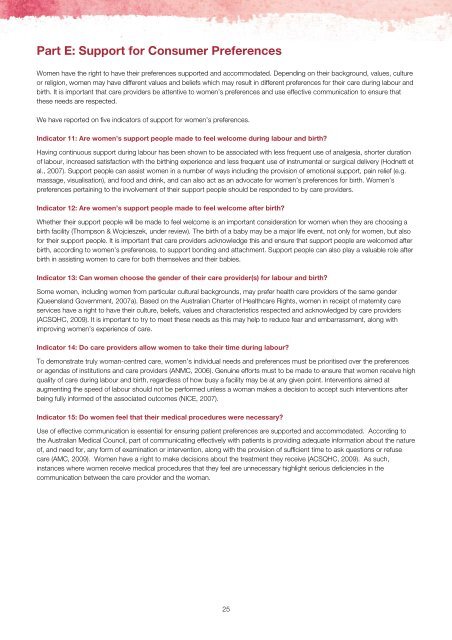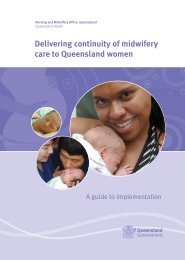Proserpine Hospital - Queensland Centre for Mothers & Babies
Proserpine Hospital - Queensland Centre for Mothers & Babies
Proserpine Hospital - Queensland Centre for Mothers & Babies
Create successful ePaper yourself
Turn your PDF publications into a flip-book with our unique Google optimized e-Paper software.
Part E: Support <strong>for</strong> Consumer Preferences<br />
Women have the right to have their preferences supported and accommodated. Depending on their background, values, culture<br />
or religion, women may have different values and beliefs which may result in different preferences <strong>for</strong> their care during labour and<br />
birth. It is important that care providers be attentive to women’s preferences and use effective communication to ensure that<br />
these needs are respected.<br />
We have reported on five indicators of support <strong>for</strong> women’s preferences.<br />
Indicator 11: Are women’s support people made to feel welcome during labour and birth<br />
Having continuous support during labour has been shown to be associated with less frequent use of analgesia, shorter duration<br />
of labour, increased satisfaction with the birthing experience and less frequent use of instrumental or surgical delivery (Hodnett et<br />
al., 2007). Support people can assist women in a number of ways including the provision of emotional support, pain relief (e.g.<br />
massage, visualisation), and food and drink, and can also act as an advocate <strong>for</strong> women’s preferences <strong>for</strong> birth. Women’s<br />
preferences pertaining to the involvement of their support people should be responded to by care providers.<br />
Indicator 12: Are women’s support people made to feel welcome after birth<br />
Whether their support people will be made to feel welcome is an important consideration <strong>for</strong> women when they are choosing a<br />
birth facility (Thompson & Wojcieszek, under review). The birth of a baby may be a major life event, not only <strong>for</strong> women, but also<br />
<strong>for</strong> their support people. It is important that care providers acknowledge this and ensure that support people are welcomed after<br />
birth, according to women’s preferences, to support bonding and attachment. Support people can also play a valuable role after<br />
birth in assisting women to care <strong>for</strong> both themselves and their babies.<br />
Indicator 13: Can women choose the gender of their care provider(s) <strong>for</strong> labour and birth<br />
Some women, including women from particular cultural backgrounds, may prefer health care providers of the same gender<br />
(<strong>Queensland</strong> Government, 2007a). Based on the Australian Charter of Healthcare Rights, women in receipt of maternity care<br />
services have a right to have their culture, beliefs, values and characteristics respected and acknowledged by care providers<br />
(ACSQHC, 2009). It is important to try to meet these needs as this may help to reduce fear and embarrassment, along with<br />
improving women’s experience of care.<br />
Indicator 14: Do care providers allow women to take their time during labour<br />
To demonstrate truly woman-centred care, women’s individual needs and preferences must be prioritised over the preferences<br />
or agendas of institutions and care providers (ANMC, 2006). Genuine ef<strong>for</strong>ts must to be made to ensure that women receive high<br />
quality of care during labour and birth, regardless of how busy a facility may be at any given point. Interventions aimed at<br />
augmenting the speed of labour should not be per<strong>for</strong>med unless a woman makes a decision to accept such interventions after<br />
being fully in<strong>for</strong>med of the associated outcomes (NICE, 2007).<br />
Indicator 15: Do women feel that their medical procedures were necessary<br />
Use of effective communication is essential <strong>for</strong> ensuring patient preferences are supported and accommodated. According to<br />
the Australian Medical Council, part of communicating effectively with patients is providing adequate in<strong>for</strong>mation about the nature<br />
of, and need <strong>for</strong>, any <strong>for</strong>m of examination or intervention, along with the provision of sufficient time to ask questions or refuse<br />
care (AMC, 2009). Women have a right to make decisions about the treatment they receive (ACSQHC, 2009). As such,<br />
instances where women receive medical procedures that they feel are unnecessary highlight serious deficiencies in the<br />
communication between the care provider and the woman.<br />
25
















